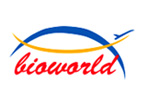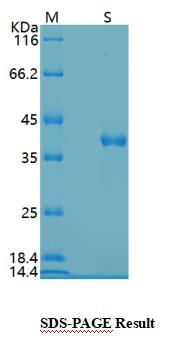Product Name :
CD172g Recombinant Protein Swiss-Prot :
Q9P1W8 Host :
E.coli Tag :
≥0.5mg/ml Amino acid Sequence :
EEELQMIQPEKLLLVTVGKTATLHCTVTSLLPVGPVLWFRGVGPGRELIYNQKEGHFPRVTTVSDLTKRNNMDFSIRISSITPADVGTYYCVKFRKGSPENVEFKSGPGTEMALGAKPSAPVVLGPAARTTPEHTVSFTCESHGFSPRDITLKWFKNGNELSDFQTNVDPTGQSVAYSIRSTARVVLDPWDVRSQVICEVAHVTLQGDPLRGTANLSEAIRVPPTLEVTQQPMRVGNQVNVTCQVRKFYPQSLQLTWSENGNVCQRETASTLTENKDGTYNWTSWFLVNISDQRDDVVLTCQVKHDGQLAVSKRLALEVTVHQKDQSSDATP Restriction sites :
NdeI-XhoI Background :
SIRPs (signal-regulatory proteins) are a family of transmembrane glycoproteins that were identified by their association with the Src homology 2 domaincontaining protein-tyrosine phosphatase SHP-2 in response to Insulin. The SIRP family negatively regulates the PI 3-K pathway, which may diminish EGFR-mediated motility and survival phenotypes that contribute to transformation of certain cell types. SIRP-α1 is a transmembrane protein which contains an extracellular portion with three immunoglobulin-like structures and a cytoplasmic region with four potential tyrosine phosphorylation sites. SIRP-α1 is a substrate for activated receptor tyrosine kinases. In its tyrosine phosphorylated form, SIRP-α1 binds to SH-PTP2 through SH2 interactions and acts as an SH-PTP2 substrate. SIRP-α1 has been shown to have negative regulatory effects on cellular responses induced by growth factors, oncogenes and insulin. SIRP-β1 shares extensive sequence homology with SIRP-α1 in its extracellular portion but lacks the cytoplasmic portion. SIRP-γ, originally designated SIRP-β2 (SIRP-B2, CD172g) has unique characteristics from both the α and β versions. SIRP-γ is expressed on the majority of T cells and a proportion of B cells. CD47 associates with SIRP-γ, and this interaction signals unidirectionally only. Soluble :
PBS, 4M Urea, PH7.4 Purification&Purity :
Transferred into competent cells and the supernatant was purified by NI column affinity chromatography and the purity is > 85% (by SDS-PAGE). Storage&Stability :
Store at 4°C short term. Aliquot and store at -20°C long term. Avoid freeze-thaw cycles. Expression vector :
pet-22b(+) BiowMW :
~37kDa Note :
For research use only, not for use in diagnostic procedure. concentration :
≥0.5mg/ml
CD172g Recombinant Protein Swiss-Prot :
Q9P1W8 Host :
E.coli Tag :
≥0.5mg/ml Amino acid Sequence :
EEELQMIQPEKLLLVTVGKTATLHCTVTSLLPVGPVLWFRGVGPGRELIYNQKEGHFPRVTTVSDLTKRNNMDFSIRISSITPADVGTYYCVKFRKGSPENVEFKSGPGTEMALGAKPSAPVVLGPAARTTPEHTVSFTCESHGFSPRDITLKWFKNGNELSDFQTNVDPTGQSVAYSIRSTARVVLDPWDVRSQVICEVAHVTLQGDPLRGTANLSEAIRVPPTLEVTQQPMRVGNQVNVTCQVRKFYPQSLQLTWSENGNVCQRETASTLTENKDGTYNWTSWFLVNISDQRDDVVLTCQVKHDGQLAVSKRLALEVTVHQKDQSSDATP Restriction sites :
NdeI-XhoI Background :
SIRPs (signal-regulatory proteins) are a family of transmembrane glycoproteins that were identified by their association with the Src homology 2 domaincontaining protein-tyrosine phosphatase SHP-2 in response to Insulin. The SIRP family negatively regulates the PI 3-K pathway, which may diminish EGFR-mediated motility and survival phenotypes that contribute to transformation of certain cell types. SIRP-α1 is a transmembrane protein which contains an extracellular portion with three immunoglobulin-like structures and a cytoplasmic region with four potential tyrosine phosphorylation sites. SIRP-α1 is a substrate for activated receptor tyrosine kinases. In its tyrosine phosphorylated form, SIRP-α1 binds to SH-PTP2 through SH2 interactions and acts as an SH-PTP2 substrate. SIRP-α1 has been shown to have negative regulatory effects on cellular responses induced by growth factors, oncogenes and insulin. SIRP-β1 shares extensive sequence homology with SIRP-α1 in its extracellular portion but lacks the cytoplasmic portion. SIRP-γ, originally designated SIRP-β2 (SIRP-B2, CD172g) has unique characteristics from both the α and β versions. SIRP-γ is expressed on the majority of T cells and a proportion of B cells. CD47 associates with SIRP-γ, and this interaction signals unidirectionally only. Soluble :
PBS, 4M Urea, PH7.4 Purification&Purity :
Transferred into competent cells and the supernatant was purified by NI column affinity chromatography and the purity is > 85% (by SDS-PAGE). Storage&Stability :
Store at 4°C short term. Aliquot and store at -20°C long term. Avoid freeze-thaw cycles. Expression vector :
pet-22b(+) BiowMW :
~37kDa Note :
For research use only, not for use in diagnostic procedure. concentration :
≥0.5mg/ml
Blocking peptide available as NCP0295P

 CD172g Recombinant Protein
CD172g Recombinant Protein 
 Datasheet
Datasheet COA
COA MSDS
MSDS SHIP
SHIP